The NSW planning system is an ever-changing landscape. With a multitude of changes occurring in only the last 6 months, it can be hard to keep up. So, we’ve outlined some of the key changes to assist our peers and industry professionals below.
The NSW government continues to introduce reforms intended to streamline the planning system. An example of this is the consolidation of 45 former State Environmental Planning Policies (SEPPs) into 11 new SEPPs which came into effect on 1 March 2022. This is in addition to the new Housing SEPP which had already come into effect on 26 November 2021.
Similarly, the Environmental Planning and Assessment Regulation 2021 replaced the 2000 Regulation on 1 March 2022. The changes sought to simplify the planning system, increase transparency, reduce assessment timeframes, and cut the red tape. From 1 July 2022, all environmental impact statements (EIS) for state significant development (SSD) and state significant infrastructure (SSI) projects will need to be reviewed by a Registered Environmental Assessment Practitioner (REAP), except where transitional arrangements apply.
A new approach to rezoning in NSW is expected to be introduced this year, to reduce processing timeframes, establish appeal pathways to overcome delays and to provide greater transparency, efficiency and certainty.
A review of Clause 4.6 of the Standard Instrument Local Environmental Plan (LEP) is also underway which aims to improve accountability and transparency in the planning system and to clarify requirements for varying development standards.
Industrial and Business zones are being reformed, with proposed changes currently on exhibition until 12 July 2022. The mew “Employment zones” will be in place within individual LEPs by 1 December 2022 when the Business and Industrial zones will be repealed.
As we can see, the planning system is undergoing serious overhaul at present, with the framework changing regularly. With the dynamic nature of the planning system, de Witt consulting is committed to staying up to date with proposed and current changes within the system. This demonstrates our commitment to providing the highest level of service as planning and development professionals.

